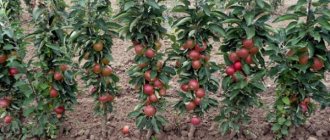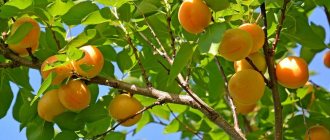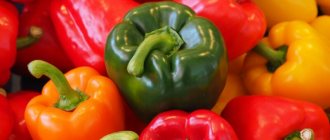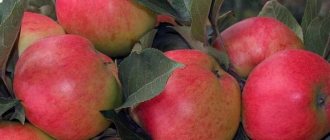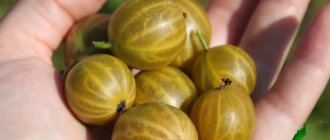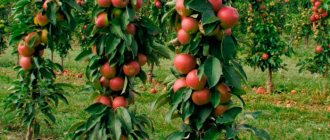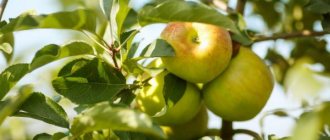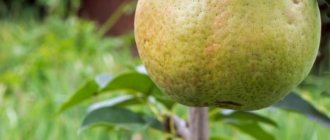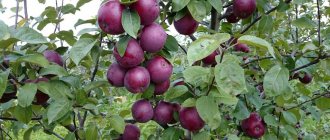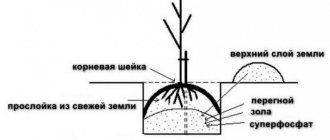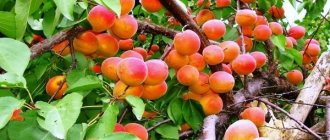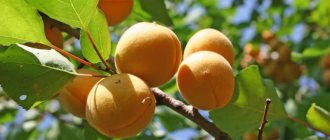What is a columnar apple tree
The first sample was obtained in the 60s of the last century thanks to a spontaneous mutation accidentally noticed on an old apple tree: one branch of the tree was unusually large, without side branches, covered with a large number of apples.
Breeders were able to propagate it and did significant work to improve the characteristics of the original sample. As a result, the first hybrids of columnar apple trees were obtained.
Columnar apple trees have lateral branches that extend from a very thick trunk at a very sharp angle and grow almost along the trunk. Branching in columns is less active than in ordinary apple trees and depends on the integrity of the apical bud: if the bud is frozen or damaged, then the activity of lateral branching increases, and the growth of the main trunk stops.
All columnar apple trees of any variety are not a variety of dwarf varieties. This is an independent type of cultivated apple tree.
Apple trees for the Urals
This territory is characterized by a mountainous, sharply continental climate. It is characterized by a sharp change of seasons, large amounts of precipitation, as well as spontaneous changes in temperature. Columnar varieties of apple trees for the Urals adapt well to such conditions.
In the Urals, varietal varieties will delight you with a good harvest:
- "Vasyugan";
- "Currency";
- "The president";
- "Nectar";
- "Iksha".
In this climate zone, species with increased resistance to cold and low temperatures will take root well.
Features of a columnar apple tree
This species received its name because of its unusual shape in the form of a column, so it is more correct to call columnar apple trees - columnar. Sometimes there is a second name - pyramidal apple trees, since without formation the crown resembles a pyramidal poplar.
Height
The height of the apple tree depends on the type of rootstock. Currently, breeders work mainly with dwarf and semi-dwarf rootstocks. Medium-growing and tall-growing rootstocks are used less frequently.
Unfortunately, the capricious apple tree does not successfully develop and bear fruit on all dwarf rootstocks. The best results in terms of early fruiting and productivity are shown by apple trees on dwarf rootstocks.
The growth of an adult columnar apple tree reaches 2.5 meters.
Productivity
The concept of high yield of columnar varieties is very relative. Productivity can be called high. But do not forget that due to the modest size of the tree, the planting density increases greatly. This means that from 1 hectare of columnar apple orchard you can harvest the same amount as from 1 hectare of ordinary apple trees. Only due to the fact that there will be tens of times more columns on the site.
Columnar apple trees.
On average, up to 12 kg of apples can be collected from one adult column.
What year does it bear fruit?
Columns are distinguished by very early fruiting. Depending on the variety, even in the first year it will be possible to pick several apples; at the age of 4-5 years, the harvest will reach an average of 4 kg; at an older age, an apple tree can produce 10-15 kg.
How many years do columnar apple trees bear fruit?
The lifespan of columnar apple trees is very short. Intensive fruiting, unfortunately, quickly depletes vital resources and by the age of 15 the tree begins to fade. To extend its useful life, it is necessary to regularly feed and properly care for the tree.
Root system
The root system of the rootstock of columnar apple trees is fibrous and is located shallow in the ground. To provide it with vital resources, regular, thorough watering is necessary. The main thing is not to allow water to stagnate in the root hole, otherwise it can cause root rot.
Pruning columnar apple trees
When to prune
Biologically, a columnar apple tree should not have branches at all, so there is no need to talk about the formation of a crown. Only the side branches are pruned, and this process is carried out at the beginning of summer or after leaf fall, when preparing the apple tree for wintering.
How to trim
The main principle of pruning is that the more you cut, the more actively what you cut will grow back. For example, if you shorten a branch by more than half, leaving only 3-4 eyes, they will give you 3-4 powerful shoots over time. And if you remove only a third of the branch, then 7-8 branches of medium strength will grow from the remaining buds. If you prune a columnar apple tree correctly, then every year it will give you 10-15 cm of growth and 2-3 lateral buds.
When pruning columnar apple trees, remember that in no case should you cut the central conductor, since if the growth point is cut off, the tree will begin to branch.
In early spring, in the first year of life of a columnar apple tree, its side branches are cut off, leaving 2 buds on them. In the next 2-3 years, fruit links are formed from new shoots. It is advisable to carefully pluck out unnecessary side shoots while they are still green, since wounds after pruning woody shoots heal much more difficult.
Spring pruning
Before sap flow begins, formative pruning of columnar apple trees is carried out. In the first year, the side branches are cut off, leaving only 2 buds on each. In addition, crossing, diseased and frostbitten branches are cut out for sanitary purposes.
In the second year, at the same time, fruit links are formed: from the two shoots that grew on the branch cut last year, the one that occupies a more horizontal position is left, and the second, more vertical one is cut to two buds. A horizontal shoot will bear fruit this summer, and a vertical shoot will produce 2 strong shoots.
- Timing and methods of grafting fruit trees
In the third spring, the shoot that bore fruit last summer is cut out, and the rest are pruned in the same way as last year. Each fruit link functions for 3-4 years, after which it is cut into a ring.
If the apical point of growth has died, cut the conductor, leaving only two buds, wait until the side branches begin to grow under it, select one of them that grows strictly vertically - this branch will replace the conductor. Cut the remaining side branches into a stump, that is, short, but not into a ring: the length of the stumps should be equal to the length of ordinary rings.
Pruning in autumn
In autumn, columnar apple trees are pruned only out of extreme necessity.
Columnar apple trees: pros and cons
Like any other fruit trees, columns have their advantages and disadvantages. The advantages include the following characteristic features:
- small size. One tree takes up very little space, which significantly saves space in the garden. One apple tree accounts for about 50-100 square meters. cm;
- very high precocity – some varieties can please the owner with a small harvest already in the first year;
- high yield for a very compact tree;
- decorativeness. The tree looks impressive and unusual both during flowering and during fruiting;
- seedlings on winter-hardy rootstock can be grown in regions with harsh winters;
- high immunity to various diseases;
- small height of the tree, which greatly facilitates harvesting.
Flowering of columnar apple trees.
Among the shortcomings, what scares gardeners the most is the high cost of one seedling. In addition, there are other objective reasons that make you think about whether such an expensive purchase is necessary:
- short life span of the tree;
- To get large harvests, you need to plant a lot of trees. These are very serious material costs;
- too labor-intensive maintenance, demanding care (frequent watering, fertilizing, preparation for wintering);
- the need for proper crown formation.
Reviews from gardeners are very contradictory: there are many satisfied with their pets. But there are also those who are not delighted with the growing process or the taste of the fruit.
Differences between columnar, pyramidal and cone-shaped apple trees from ordinary varieties
There is an answer: plant varieties of apple trees that are included in the columnar category; they take up significantly less space than standard varieties of apples. Let's take a closer look at the different varieties of columnar apple trees and learn about their advantages and disadvantages.
Unlike other varieties of apple trees, mainly bred by breeders, these apple trees appeared through the process of mutation. In the 1950s, a Canadian farmer noticed a strange branch on an apple tree in his garden; there were no shoots on it, and the fruits were located on the branch itself.
Well, for the sake of experiment, this same farmer decided to graft cuttings of this shoot onto the rootstocks of other varieties of apple trees and eventually got a new species, which is compact.
Many scientist-breeders from various countries became interested in these apple trees, who developed many previously unknown varieties, and some of them are still in quite high demand among summer residents and gardeners.
All these varieties differ in a number of characteristics:
- crown shape (pyramidal, cone-shaped, columnar);
- yield indicator;
- fruit size and color.
But what all varieties have in common is that they do not take up much space, so they can be grown in large quantities even in a relatively small area.
Popular varieties
Like all types of apple trees, columnar apple trees are divided according to ripening periods into early (summer), autumn and winter.
Early
Popular columnar varieties of summer apple trees:
- Nectar;
- The president;
- Early;
- Iksha.
Early apple variety Medoc.
Autumn
Autumn varieties that have received good ratings among gardeners:
- Malyukha;
- Ostankino;
- Chervonets;
- Moscow necklace;
- Vasyugan;
- Amber necklace.
Autumn apple tree variety Malyukha.
Winter
Varieties of winter columnar apple trees:
- Currency;
- Elite;
- Arbat;
- Trident.
Winter variety of columnar apple tree Currency.
Varieties with rich harvest
Columnar-shaped fruit trees are a decoration for the backyard and garden. But their main role is fruiting.
The most productive varieties, characterized by a rich and tasty harvest, are as follows:
- Currency;
- Moscow necklace;
- Ostankino;
- Amber necklace;
- The president;
- Malyukha;
- Iksha.
These varieties always give guaranteed results.
The president
There are many leaves on the thick side shoots. The leaf blade of the President variety is elongated. The leaf sizes are large. The edge is serrated. Fruit formations form throughout the entire height of the tree. The apples are spherical, slightly flattened. The color is yellow with a few pinkish stripes. The President's appearance is easily recognizable. The pulp is fine-grained. It contains a large amount of juice. The juice is sour, but the sweet taste predominates. The President apple tree can produce up to 16 kg of yield per plant. This variety is ideal for preparations, canning and confectionery.
Malyukha
The Malyukha apple tree is small in size. The height of the central axis does not exceed 170-180 cm. The maximum yield of this variety is up to 13 kg of yield in one growing season.
Characteristics of apples:
- elongated, oblong shape;
- skin color is light yellow;
- weight 110-120 g;
- there is a sour aftertaste.
This type is suitable for canning and preparing confectionery products. Fruiting is activated 2 years after planting young seedlings.
Currency
A species with high winter hardiness. The currency tolerates cold well, as well as temperature changes. The height of the plant is typical for this variety and does not exceed 2 m. The main advantage of the variety is considered to be resistance to the negative effects of diseases and parasitic organisms.
The Currency apple tree has an interesting feature. Its leaves do not change color in autumn. They fall off, remaining green. Therefore, Currency is often used for decorative purposes on alpine slides.
Large fruits form on the tree. The weight of one apple can reach 250 g. The skin is yellow-red. The pulp is juicy and sweet. The sourness in the taste is practically not noticeable. This type has good keeping quality. Therefore, apples can be stored for a long time, maintaining a beautiful appearance.
Moscow necklace
Like most representatives of this variety, this species is not bulky in size. The average quantity of apples is 10 kg. Large apples are spherical. The color is yellowish-light green, with a pinkish blush on one side. The apple pulp is very juicy, with a crunch. The taste is sweet due to the high content of fruit sugars, with notes of sourness.
Ostankino
One of the first varietal varieties that began to be cultivated in the gardens of summer residents. A low-growing species, the height of which does not exceed 2 m. There are many large oblong leaves on the shoots. The shade of the leaf blade is dark green.
Ostankino is one of the best varieties of columnar apple trees for growing in the Moscow region. 24 months after transplanting the young plant into the soil, the first fruits appear. The apples are sweet, but not cloying. The pulp is white, very juicy and crispy. There is a slight sourness.
Amber necklace
A winter-hardy variety that is very demanding on soil composition. The tree produces fruits of a beautiful yellow-orange color. The maximum yield is 20 kg of apples per plant. Sweet and flavorful apples store well under the right conditions.
Iksha
An early ripening variety that will delight you with its first fruits a year after planting the seedlings.
Characteristic:
- The apple tree tolerates frost well;
- fruits can be stored for a long time without losing their appearance;
- disease resistance;
- resistance to parasites;
- the color of the apples is light green with a yellowish tint;
- taste sweet;
- the pulp has a yellowish tint and pronounced granularity.
How to propagate a columnar apple tree
Reproduction of columnar varietal apple trees is a troublesome task. Therefore, the best option is to buy a ready-made seedling from a nursery. But such an opportunity is not always available, therefore, you can try to get a high-quality core seedling yourself, and for this you will have to work hard.
Columnar fruit trees are propagated in the same ways as ordinary ones. There are several options:
- grow a new tree from seeds;
- graft onto the rootstock;
- get air layering.
Propagation by seeds takes too long, and besides, seeds do not always grow into a tree that carries all the useful and necessary qualities of the parent tree. In this case, you will have to spend a lot of effort and time growing seedlings. This method is not popular among specialists, since it gives a high percentage of the probability of obtaining substandard seedlings that will not be carriers of the Co gene.
Experienced gardeners most often use grafting of a varietal apple tree onto a rootstock. In nurseries, Paradise or Malysha Budagovsky rootstocks are often used as rootstock material. In a private backyard, you can try to take an ordinary local seedling. Vaccination does not guarantee that the graft will take root. It is especially risky to vaccinate without experience in this matter.
The best option for a gardener with little experience is to get layering. Columns can be propagated by air layering. This method does not require any special skills, and the offspring obtained in this way acquires all the characteristic varietal characteristics. In this case, the maternal specimen is minimally injured. This is a vegetative method of propagation, which will help to obtain offspring with one hundred percent inheritance of all parental qualities.
Landing
Planting colonies, like ordinary apple trees, can be done both in autumn and spring . Experienced gardeners recommend spring planting before buds open , explaining that during the season the seedling will take root well, get stronger and gain strength for wintering.
Planting is done with annual seedlings , which tolerate the transplantation process more easily and take root faster. The planting holes must be of sufficient size so that the roots of the seedling can be freely located in them.
Planting scheme for columnar apple trees.
More on Tele4n.Net:
Apple tree Honey (Honey) Crisp: photo and description of the variety, reviews
Important! It is not advisable to apply full mineral fertilizer to planting holes, since the unrooted plant root system cannot absorb many nutrients, and their excess has a bad effect on its development.
If the seedlings are planted correctly, then during the growing season they should give 20-30 cm of growth.
Read more about planting columnar apple trees here.
Growing columnar apple trees
The undoubted advantage of these apple trees is their high planting density. Therefore, in a very small area you can grow trees of several varieties with different periods of fruit ripening.
Growing columnar apple trees.
Cultivation is complicated by the demands of columnar plants on the soil. You will have to fertilize and feed the apple tree at least once every two weeks. It is advisable to combine the first spring and last autumn fertilizing with treatment against diseases and pests.
Also, it is necessary to provide the tree with regular watering, since the roots are located close to the surface. The plant especially needs watering during flowering and ovary growth.
In the first year of planting a seedling, it is advisable to pick off the flowers that appear, sacrificing the potential harvest. This will make it possible to direct the main forces of the tree to good rooting. But next year the apple tree will thank its owner with a bountiful harvest.
The tree trunk circle must be kept in perfect order: constant weeding and garbage removal are required.
Caring for columnar apple trees
Spring care conditions
In the spring, before the buds begin to bloom, columnar apple trees are pruned and preventively treated against pests and diseases, and they are also fed with nitrogen fertilizers.
When apple trees begin to form buds, they are carefully removed from newly planted trees, ten flowers can be left on apple trees of the second year of life, and on older trees the load is gradually increased, leaving only twice as many flowers as the apples should ripen. In total, two inflorescences are left on the fruit links, postponing repeated thinning until the summer.
In addition to pruning, fertilizing and thinning, apple trees need watering and loosening the soil in the trunk circle, however, if you grow trees on clonal rootstocks, then by loosening you can damage the roots. In this case, it is better not to mulch, but to tin the tree trunk circle - sow green manure within a radius of 25 cm from the trunks and mow them regularly.
Caring for a columnar apple tree in summer
In the first half of June, complex feeding of columnar apple trees with mineral fertilizers is carried out. As soon as the ovaries appear on the apple trees, the future harvest is thinned out again - only half of the formed ovaries are left on the branches. When the future apples become the size of a cherry, only two ovaries are left in each inflorescence, and when the fruits reach the size of a walnut, one of the two ovaries is left - in total, one apple will be poured on each fruit-bearing link.
In the summer, you need to carefully monitor the appearance of pests in the garden and any changes in the appearance of the apple trees, so as not to miss the onset of any disease, and if you are able to diagnose the problem, take action immediately, otherwise the harvest will be in jeopardy. Columnar apple trees are treated against pests and diseases no later than a month before harvest.
- Video about growing and propagating blackberries
Starting in August, they stop feeding apple trees with organic matter and nitrogen fertilizers - at this time the trees need potassium much more, which helps young shoots to ripen faster. To prevent the tops of the shoots of columnar apple trees from freezing in winter, the leaf blades of each of the 4 upper leaves are shortened by two-thirds.
Autumn care
In the fall, after harvesting, the apple trees are fed, treated against fungi and pests hidden in the bark and soil of the tree trunk, sanitary pruning is carried out, if necessary, and the apple trees are prepared for wintering.
Processing columnar apple trees
In early spring, before the start of sap flow, and in the fall, after leaf fall, preventative treatment of columnar apple trees and the soil in the tree trunk is carried out against diseases and pests. Typically, a one percent solution of Bordeaux mixture or Nitrafen is used for this. The purpose of such treatments is to destroy pathogenic microorganisms and pests located in the bark of trees and in the soil. Some gardeners use a seven percent urea solution for spring spraying, which in this case is not only an insecticide and fungicide, but also a timely nitrogen supplement for columnar apple trees.
Watering
Since columnar apple trees do not have a tap root that goes deep, and their root system is located superficially within a radius of only 25 cm from the trunk, young trees will have to be watered once every three days in normal summer weather. If the summer is hot and dry, then be prepared to moisten the soil under the apple trees every other day, and maybe every day. For more mature apple trees, watering once or twice a week is sufficient. From mid-June, apple trees are watered less frequently, and in August, watering is stopped completely so that the tree has time to form flower buds, finish growing and prepare for winter.
To ensure that moisture remains in the soil longer and a crust does not form on its surface, the tree trunk circle is mulched with straw or sown with green manure. The best way to water columnar apple trees is by drip, with a dosed supply of moisture to the root system, but once a month you should still water thoroughly to wet the soil in the tree trunk to the depth of the roots. Twice a month after sunset you need to generously water the crowns of columnar apple trees with a hose.
Top dressing
By forming a huge number of fruits, columnar apple trees extract all the useful substances from the soil, so fertilizing the apple orchard is carried out throughout the entire growing season. In the spring, organic fertilizers are applied to the trunk circles of columnar apple trees. This could be slurry or fermented chicken droppings. As a foliar nitrogen fertilizer, you can treat trees with a seven percent urea solution in early spring, before the buds swell. Later, until mid-summer, you can carry out two more foliar feedings of apple trees with urea with a concentration of 0.1%.
At the height of the growing season - in the first half of June - apple trees need complex mineral fertilizers, and from August organic substances are excluded from the composition of fertilizing, since the trees at this time only need potassium, which accelerates the ripening of the tops of apple tree shoots.
Wintering columnar apple trees
With the onset of autumn, for the trunks of young columnar apple trees, you need to create a reliable shelter with spruce branches or wood shavings - it must be dry and protected from rodents. Do not use straw for this purpose, and if you mulched the tree trunk with it throughout the spring and summer, it should be removed in the fall, since straw attracts mice and rats. After the snow falls, cover the base of the apple tree with it.
Landing Features
Column seedlings are planted in the ground in spring and autumn. It is better to plant annual seedlings. The basic requirements are the same as for ordinary apple trees:
- the planting hole for the seedling must be prepared in advance;
- the size of the hole should not exceed 50 cm in diameter - this is enough for comfortable placement of the roots;
- Organic fertilizer can be added to the hole, which must be separated from the roots with a layer of soil so as not to cause burns to the roots;
- when planting, the grafting site should not be buried in the soil - it should protrude above the ground by about 2-3 cm;
- the root hole needs to be mulched.
Planting columnar apple trees
When to plant
Columnar apple trees are best planted in early spring, before the buds on the trees begin to bloom, but planting is also permissible in warm weather at the end of September or beginning of October. It is better to purchase annual columnar apple tree seedlings - they take root much easier than two-year-old ones, grow faster and begin to bear fruit, however, when choosing planting material, make sure that the roots of the seedlings are not overdried or rotten. Give preference to planting material in a container - it can be planted in the ground even in summer.
The site for columnar apple trees is chosen to be open, with free access to sunlight and heat, but protected from strong winds. The soil on the site should be moisture-permeable, fertile, and the groundwater level should not be higher than 2 meters.
Planting in autumn
If you decide to plant not one or two trees, but a full-fledged apple orchard, place the seedlings in a row at a distance of half a meter from each other, leaving row spacing 1 m wide. Holes for seedlings measuring at least 90x90x90 cm must be prepared at least two weeks before planting, otherwise, if you plant trees without preliminary preparation, the root collar may end up underground after settling, and this should not be allowed.
When digging holes, throw the fertile layer of soil to one side and the bottom layer to the other so that they do not mix. If you plant apple trees in heavy soil, be sure to place a drainage layer of sand and crushed stone at the bottom of the hole. Then add 3-4 buckets of compost or humus, 50-100 g of potassium fertilizer and 100 g of superphosphate to the fertile soil, and if the soil on the site is acidic, also add 100-200 g of dolomite flour, mix well, place the soil mixture in the hole, level and leave for two weeks to allow the soil to settle and compact.
After half a month, pour the rest of the soil mixture into the hole in a heap, place the seedling on it so that its root collar is slightly above the surface of the site, straighten its roots, fill the hole with infertile soil from the bottom layer, compact the soil and form around each one at a distance of 30 cm from the stem. tree in a circular hole with a roller 10-15 cm high. After planting, pour 1-2 buckets of water into each hole, and when it is absorbed, mulch the tree trunk circle with peat, sawdust or cut grass.
If you are worried that a gust of wind might break the apple tree, drive a peg near it and tie the tree to it.
How to plant in spring
If you are planning to plant columnar apple trees in the spring, it is better to prepare holes for them in the fall - over the winter the soil in them will settle, compact, fertilizers will dissolve, and the roots of your seedlings will end up in fertile nutritious soil, which will allow them to quickly grow and, perhaps, even bloom. Otherwise, the procedure for planting columnar apple trees in spring is no different from the autumn one.
Features of care
The tree's short stature and small volume make it easy to care for and easy to harvest. No special tools or equipment are needed: all manipulations can be performed while standing nearby, right on the ground. The branching nature of columnar plants makes it possible to get as close to the trunk as possible without the risk of injury or being scratched by branches.
Pruning diagram for a columnar apple tree.
When preparing for winter, it is advisable to wrap the apple tree with covering material, and protect the trunk from rodents with a special net.
Trimming and shaping
Most often you can see columns with one trunk, but some experts recommend forming a tree with two or even three trunks. This is necessary in regions with cold winters in order to insure in case the apical bud of one of the trunks freezes out.
To prevent the tree from losing its shape, it is necessary to prune regularly. This procedure begins to be performed when the seedling reaches two years of age. Since the tree grows from the apical bud of the trunk, and strong branching is not necessary, it is not advisable to form a crown. All pruning consists of shortening the side shoots in the spring and simply regulating their growth in the future.
Gin
One of the main advantages of the Gin variety is that it is highly resistant to pests and various diseases of apples and is practically not susceptible to scab.
Apple trees tolerate low temperatures well, but due to their shallow root system they can suffer in especially cold winters. For this reason, it is recommended to insulate the tree trunk and tree trunk for the winter.
The fruits of the Jin apple tree are spherical in shape with a glossy sheen, medium in size, and colored bright red. The pulp is dense, juicy, sweet and sour. Due to their long shelf life (in a cool place, apples do not lose their taste for up to six months), they are mostly consumed fresh.
| Entry into fruiting | Tree height (m) | Fruit weight (g) | Harvest | Shelf life |
| For the 2nd year | 2 | 120-170 | September | 6 months |
Pest and disease control
To prevent various insects from encroaching on the harvest or preventing tree disease from making it impossible to eat an apple, it is necessary to properly prepare the garden for the fruiting season.
Spraying a columnar apple tree.
In spring, processing is carried out in several stages:
- before the start of active sap flow, sanitary pruning of trees is carried out;
- in late April-early May, garden whitewash is applied to the trunks, which will prevent infection and get rid of overwintered pests;
- Before flowering, trees are sprayed with fungicides and insecticides.
In the fight against insects, trapping belts are often used to prevent pests from moving up the trunk.
Planting and caring for a columnar apple tree
- Planting: in spring, before sap flow begins, or in late September-early October.
- Flowering: in May.
- Lighting: bright sunlight.
- Soil: fertile, neutral.
- Watering: young trees - once every three days, in heat and drought - every other day or daily. Mature trees - once or twice a week. From mid-July, watering is gradually reduced, and in August it is stopped completely. The best method of watering is drip.
- Fertilizing: regular: in the spring - 2-3 nitrogen, organic (fermented solution of chicken manure or mullein) fertilizing, until mid-summer - 2-3 foliar fertilizing with urea, in the first half of July complex mineral fertilizer is applied, and from August only mineral phosphorus and potassium fertilizers fertilizers
- Pruning: in early summer and autumn, after leaf fall.
- Reproduction: by air layering, but mainly by grafting.
- Pests: apple green and plantain aphids, sawfly, glass beetle, red mite, codling moth, moth, leaf roller, copperhead, comma scale, currant, fruit and subbark leaf rollers, fruit and fruit moths, various cutworms, rowan moth, gypsy, oakleaf and ringed silkworms , blood and red gall aphids, goose weevil, western gypsy bark beetle, sapwood, pear tubeweeper and sawfly.
- Diseases: proliferation of apple trees (witch's broom), bitter and fruit rot, mosaic disease, mosaic ringing, milky shine, fly beetle, true mulberry, common cancer, rust, black cancer, dying of branches, scab, subcutaneous viral spotting, powdery mildew, rubbery, flattened branches, glassy fruits, cytosporosis, black spot.
Read more about growing a columnar apple tree below.
